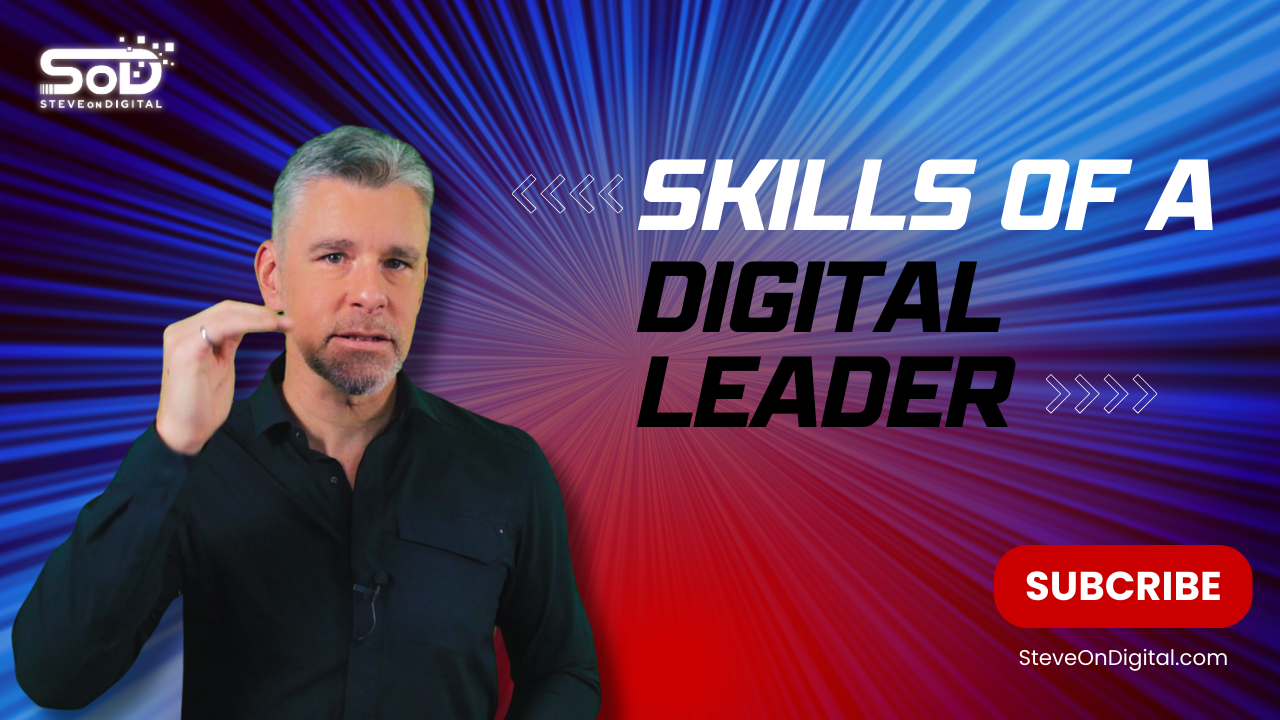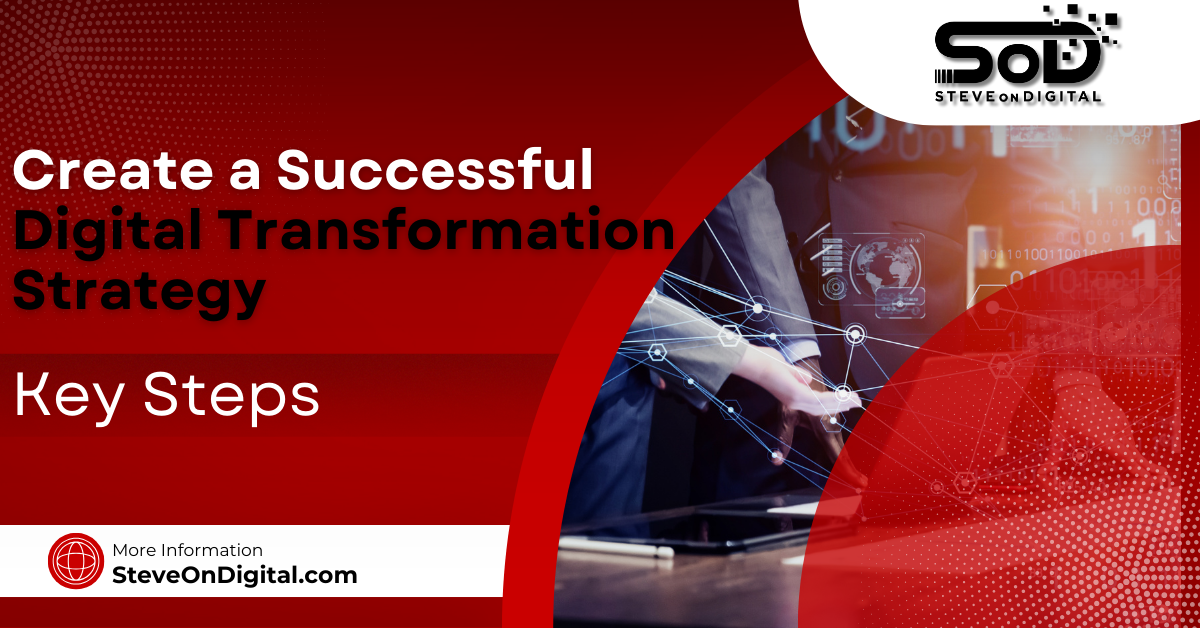Digital leadership skills are crucial for navigating the modern business landscape. A digital leader must possess strategic thinking, innovation, and effective team management abilities. These skills enable leaders to implement digital strategies, manage technological changes, and lead teams successfully. The role of the Chief Digital Officer (CDO) is pivotal in digital leadership within organizations. However, the CDO’s responsibilities can sometimes create a silo effect, isolating digital initiatives from other business operations.
In this guide, I will explore the essential skills every digital leader must have. Drawing from my personal experience and industry insights, I’ll provide practical advice on how to excel in digital leadership. Whether you are a small business owner or aspiring leader, this comprehensive guide will help you thrive in the digital age.
I’m Steve, a digital transformation expert with a strong background in electrical engineering, an MBA, and a master’s in Project Management. I excel at helping SMEs navigate the digital landscape with practical insights. Let’s begin!
Overview of Digital Leadership
Digital leadership involves guiding an organization through the complexities of digital transformation, leveraging technology to drive business success. Effective digital leaders are not only tech-savvy but also skilled in strategic thinking, innovation, and team management.
A digital transformation leader plays a crucial role in guiding organizations through significant changes, emphasizing essential skills such as inspirational leadership, strategic planning, and the ability to inspire teams toward a digital-first mindset.
Importance of Digital Skills for Leaders
In the digital age, leaders must possess a diverse set of digital skills. These skills enable them to implement digital strategies, manage technological changes, and lead their teams effectively. According to a study, 70% of new leadership skills are required to manage digital transformation successfully (DigitalDefynd). Successful digital leaders guide teams through digital transformation by fostering autonomy and open communication.
| Skill | Description |
| Strategic Thinking | Ability to set and achieve strategic goals in a digital landscape. |
| Innovation | Fostering creativity and implementing innovative solutions to challenges. |
| Team Management | Building, leading, and motivating effective digital teams. |
| Data Analysis | Leveraging data-driven insights for informed decision-making. |
| Communication | Clear and effective communication with teams and stakeholders. |
| Adaptability | Embracing change and staying current with emerging technologies. |
Visionary Thinking
Transformative Vision
A transformative vision in the digital world is crucial for understanding market trends and the necessity for organizations to adapt to continuous changes. Digital leaders must be adept at problem-solving within a digital context. For example, during my tenure, I’ve seen how a clear vision can drive successful initiatives and help businesses adapt to market changes.
Forward-Looking Perspective
Setting clear objectives and strategies is essential for any digital leader. Developing a digital roadmap helps guide the team towards achieving long-term goals. According to Gartner, 72% of data and analytics leaders are heavily involved in their organization’s digital transformation, emphasizing the need for a strategic approach (Exploding Topics).
Technology Understanding
Digital Literacy
Being literate in digital technologies is vital. This includes understanding how different technologies work and their potential impact on business processes. Past experiences with various technologies enhance a leader’s capability to drive digital initiatives.
Adapting to New Technologies
Keeping up with emerging technologies is crucial. Integrating new technologies into business processes can significantly improve efficiency and productivity. For instance, 45% of organizations are scaling up their cloud capabilities to support digital transformation efforts (Digital Adoption).
Change Orientation
Open-Mindedness
Embracing change and fostering a growth mindset are critical traits for digital leaders. Encouraging team innovation and adaptability helps navigate the challenges of digital transformation. Effective leaders are those who inspire their teams to embrace new ideas and approaches.
Managing Digital Transformation
Leading successful digital transformations involves strategic planning and execution. Overcoming common challenges in digital change requires a leader to be proactive and resilient. Despite aligned leadership, 70% of digital transformation projects fall short of their goals, highlighting the need for robust change management strategies (Fit Small Business). The Chief Transformation Officer (CTO) plays a crucial role in driving the digitization of processes, transforming traditional workflows into more efficient digital operations.
Leadership Skills
Strong Decision-Making
Effective decision-making is a cornerstone of successful digital leadership. As a digital leader, I understand the need to make pragmatic and focused decisions that drive the business forward. It’s essential to evaluate all available data, consider the potential outcomes, and choose the best course of action. According to DigitalDefynd, strategic thinking leaders achieve 33% more effective outcomes, highlighting the importance of clear and confident decision-making (DigitalDefynd). Employee engagement and clear communication are vital components of successful digital transformation, ensuring teams are equipped and informed throughout the digital journey.
Leading with clarity and confidence instills trust and motivation in your team. When your team understands the decisions being made and the reasons behind them, they are more likely to buy into the vision and work towards common goals. Clear communication of decisions ensures everyone is on the same page, reducing confusion and increasing efficiency.
Team Collaboration
Building and leading effective digital teams is critical in the digital age. A strong team can achieve great things, especially when they work well together. I’ve found that fostering a culture of collaboration and open communication helps teams tackle complex tasks more effectively. The rise of remote work has increased the importance of strong virtual team management, with remote leadership surging by 80% since early 2020 (DigitalDefynd).
Enhancing team communication and cooperation involves implementing tools and practices that facilitate seamless interaction. Digital tools like Slack, Microsoft Teams, and Asana can help streamline communication and project management. Effective leaders use these tools to ensure that team members are always connected and informed, which is essential for maintaining productivity and achieving strategic goals.
| Tool | Purpose |
| Slack | Facilitates real-time communication and collaboration among team members. |
| Microsoft Teams | Combines chat, video meetings, and file collaboration in one platform. |
| Asana | Manages tasks, projects, and workflows for teams. |
| Trello | Visualizes project progress using boards and cards. |
Strategic Thinking
Strategic Goals
Setting and achieving strategic goals in a digital landscape requires a forward-thinking approach. As a digital leader, I prioritize aligning digital strategies with broader business objectives to ensure we stay on track. According to Gartner, companies that prioritize strategic thinking in their digital initiatives are more likely to see successful outcomes (Digital Adoption).
Aligning digital strategies with business objectives ensures that all digital initiatives support the overall mission of the company. This alignment helps in maximizing resources and achieving significant milestones. For instance, 74% of organizations have prioritized digital transformation to improve process efficiency and stay competitive in the market (Exploding Topics).
Data-Driven Insights
Data analysis is crucial for informed decision-making. By leveraging data-driven insights, I can make better decisions that are backed by solid evidence. This approach helps in identifying trends, predicting outcomes, and optimizing strategies. The importance of data analysis is evident, with 72% of data and analytics leaders heavily involved in digital transformation efforts (Exploding Topics).
Leveraging data to gain a competitive edge involves using advanced analytics to understand customer behavior, market trends, and operational performance. This information is invaluable for making strategic decisions that differentiate your business from competitors. Companies that effectively use data-driven insights often see improved efficiency and higher success rates in their digital initiatives (Digital Adoption).
Customer Focus
Customer Engagement
Improving customer engagement through digital tools involves using platforms like social media, email marketing, and CRM systems to interact with customers. Effective digital leaders use these tools to create meaningful connections and provide personalized experiences. This strategy is crucial, as 92% of SMEs believe digital transformation is essential for their business growth (Digital Adoption).
Enhancing customer experience with digital products involves continuously innovating and improving your offerings. By leveraging customer feedback and data, I can refine products to meet customer needs better. A focus on customer experience helps build loyalty and drives long-term success.
Building Customer Relationships
Developing long-term customer relationships is about more than just making a sale; it’s about creating lasting connections. Regularly engaging with customers, understanding their needs, and delivering consistent value are key to fostering these relationships. Long-term relationships contribute to sustained business growth and customer loyalty.
Utilizing feedback to improve digital services involves actively seeking and acting on customer input. This practice ensures that the services provided are aligned with customer expectations and continuously improved. Engaging customers in this way not only enhances satisfaction but also drives innovation and service excellence.
Digital Vision
Defining Digital Vision
Crafting a compelling digital vision involves setting a clear direction for your digital initiatives. This vision should be ambitious yet achievable, guiding all digital efforts and inspiring your team. A well-defined digital vision is a crucial component of successful digital leadership, helping to align all stakeholders towards common goals (Exploding Topics).
Communicating the vision effectively to stakeholders ensures that everyone is on board and understands their role in achieving it. Regular updates, transparent communication, and inclusive discussions are essential for maintaining stakeholder alignment and commitment.
Digital Roadmap
Creating and following a digital roadmap provides a structured plan for achieving your digital vision. This roadmap outlines key milestones, timelines, and responsibilities, ensuring that all efforts are coordinated and progress is tracked. A clear roadmap is essential for staying focused and achieving long-term digital transformation goals (Digital Adoption).
Tracking progress and adjusting the roadmap as needed ensures that your digital initiatives remain relevant and effective. Regular reviews and updates allow for agility in response to changing market conditions and technological advancements, keeping your digital strategy on track.
Innovation and Creativity
Encouraging Innovative Ideas
Innovation begins with fostering a culture that encourages creativity. As a digital leader, I’ve learned that creating an environment where team members feel safe to share ideas is crucial. Encouraging brainstorming sessions and rewarding innovative solutions can significantly boost creativity. According to a Deloitte survey, businesses prioritizing innovation are 5X more likely to achieve breakthrough performance (Digital Adoption).
Innovative solutions are essential for overcoming business challenges. By leveraging new technologies and creative thinking, I’ve been able to implement strategies that not only solve problems but also enhance efficiency and productivity. For instance, integrating AI and machine learning can streamline operations and provide deeper insights into customer behavior.
Leveraging Technological Advancements
Staying updated with technological advancements is vital for driving innovation. I make it a point to keep abreast of emerging technologies such as AI, blockchain, and IoT. These technologies can transform business processes, making them more efficient and effective. According to Accenture, 45% of organizations are scaling up their cloud capabilities to support digital transformation (Digital Adoption).
To remain competitive, it’s important to stay ahead of market trends. I regularly analyze market data and trends to identify opportunities for innovation. This proactive approach helps in adapting to changes quickly and maintaining a competitive edge. Leveraging data-driven insights can significantly enhance strategic decision-making (Exploding Topics).
Technical Skills
Core Technical Skills
Digital leaders need a solid foundation in core technical skills. These include proficiency in digital tools, understanding digital channels, and knowledge of data analysis techniques. Continuous learning and skill development are key to staying relevant. Leaders who invest in their technical skills can better guide their teams and make informed decisions (Digital Adoption).
The digital landscape is constantly evolving, making continuous learning essential. I regularly attend workshops, webinars, and online courses to keep my skills sharp. This commitment to learning not only enhances my capabilities but also sets a positive example for my team. Emphasizing a culture of continuous improvement is critical for long-term success (Fit Small Business).
Tech Stacks
Understanding and managing tech stacks is crucial for integrating technology into business operations. A well-managed tech stack can improve efficiency, streamline processes, and enhance overall performance. I ensure that my team is well-versed in the latest tech stacks, from development frameworks to cloud services (Digital Adoption).
Integrating tech stacks with business operations involves aligning technology with strategic goals. This integration helps in optimizing workflows and achieving business objectives. By effectively managing tech stacks, I can ensure that our technology infrastructure supports our digital initiatives and drives business growth.
Communication Skills
Active Listening
Active listening is a critical communication skill for digital leaders. It involves truly hearing and understanding the perspectives of others. I make it a point to actively listen to my team, stakeholders, and customers. This approach helps in building trust, resolving conflicts, and fostering a collaborative environment (Digital Adoption).
Effective communication techniques include clear messaging, active listening, and constructive feedback. I use various tools and platforms to ensure seamless communication with my team. Regular check-ins, team meetings, and one-on-one sessions help in maintaining transparency and alignment with our goals.
Clear Communication
Communicating complex digital concepts in simple terms is essential for ensuring understanding across all levels of the organization. I often use analogies, visuals, and step-by-step explanations to convey intricate ideas. Clear communication helps in aligning the team with digital strategies and ensures everyone is on the same page (Fit Small Business).
Ensuring that the team understands digital strategies and goals is crucial for successful implementation. I regularly update the team on our progress, address any concerns, and clarify any ambiguities. This approach fosters a sense of ownership and commitment towards achieving our digital objectives.
Stakeholder Management
Aligning Stakeholders
Aligning internal stakeholders with digital initiatives requires clear communication and collaboration. I involve stakeholders early in the planning process and keep them informed throughout. By aligning stakeholders, I can ensure that everyone is working towards common goals and that there is support for our digital initiatives (Exploding Topics).
Gaining stakeholder buy-in is essential for the success of digital projects. I present clear, data-driven benefits of the projects and address any concerns stakeholders might have. Building strong relationships and demonstrating the value of digital initiatives helps in securing their support (Digital Adoption).
Managing Expectations
Setting and managing expectations is crucial for avoiding misunderstandings and ensuring smooth execution of digital transformations. I set realistic goals, provide regular updates, and communicate any changes promptly. Managing expectations helps in maintaining stakeholder trust and commitment.
Regular communication of progress and addressing concerns promptly is vital for stakeholder satisfaction. I hold regular meetings to discuss updates and gather feedback. This approach helps in identifying and resolving issues early, ensuring that the digital transformation stays on track.
Final Thoughts
In this comprehensive guide, I’ve covered the essential skills for a digital leader, including decision-making, team collaboration, strategic thinking, customer focus, innovation, technical skills, communication, and stakeholder management. Each of these skills plays a crucial role in driving successful digital transformations and leading in the digital age.
The future of digital leadership lies in continuous improvement and adaptation. As technology and market dynamics evolve, so must the skills and strategies of digital leaders. By staying informed, embracing change, and fostering a culture of innovation, digital leaders can navigate the challenges and seize the opportunities of the digital future.





